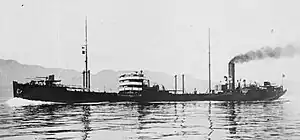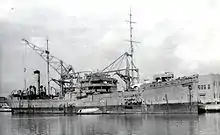 Tsurumi in 1922 | |
| Class overview | |
|---|---|
| Name |
|
| Builders | |
| Operators | |
| Preceded by | Noma |
| Succeeded by | Kamoi |
| Cost | 1,500,000 JPY |
| Built | 1919–1922 |
| In commission | 1920–1945 |
| Planned | 7 |
| Completed | 7 |
| Lost | 6 |
| General characteristics | |
| Type | Oiler |
| Displacement | 15,400 long tons (15,647 t) standing |
| Length | 138.68 m (455 ft 0 in) p/p |
| Beam | 17.68 m (58 ft 0 in) |
| Draught | 8.08 m (26 ft 6 in) |
| Propulsion |
|
| Speed | 12 knots (22 km/h; 14 mph) |
| Capacity | 8,000 tons of fuel oil |
| Complement |
|
| Armament |
|
The Notoro-class oilers (能登呂型給油艦, Notoro-gata kyūyukan) were a class of seven oilers of the Imperial Japanese Navy (IJN), serving during the 1920s and World War II. They were also called the Erimo-class oilers (襟裳型給油艦, Erimo-gata kyūyukan), after Notoro and Shiretoko were converted to other ship types.
Construction
They were built under pre-Eight-eight fleet plans, the Eight-four fleet plan and the Eight-six fleet plan. All ships of the class were named after capes in Japan (e.g. Irō is a cape at the southern tip of Izu Peninsula).
Service history
The class devoted themselves to importing crude oil from North America and Southeast Asia. The Notoro and the Ondo classes made 388 voyages carrying a total of 3,000,000 tons of oil up to 1941.
During World War II they were not able to accompany the fleet, due to their low speed. Instead they were engaged in supply duties at naval bases.
Ships in class
| Ship | Builder | Laid down | Launched | Completed | Fate |
|---|---|---|---|---|---|
| Notoro (能登呂) | Kawasaki-Kōbe Shipyard | 24 November 1919 | 17 July 1920 | 20 September 1920 | Converted to seaplane tender, 1 June 1934. Scuttled off Singapore, 12 January 1947. |
| Shiretoko (知床) | Kawasaki-Kōbe Shipyard | 24 November 1919 | 3 May 1920 | 10 August 1920 | Converted to collier, 1928. Later re-converted to munition ship. Sunk by air raid at Singapore, 1 February 1945. |
| Erimo (襟裳) | Kawasaki-Kōbe Shipyard | 3 May 1920 | 28 October 1920 | 16 December 1920 | Heavily damaged by Dutch submarine O 15, 4 March 1942 and grounded at Belitung. |
| Sata (佐多) | Yokohama Dock Company | 6 March 1920 | 28 October 1920 | 24 February 1921 | Converted to submarine rescue ship in 1938. Sunk during Operation Desecrate One at Palau, 31 March 1944. |
| Tsurumi (鶴見) | Ōsaka Iron Works, Sakurajima Factory | 10 March 1921 | 29 September 1921 | 14 March 1922 | Sunk by USS Cero south of Davao 05°53′N 125°41′E / 5.883°N 125.683°E, 5 August 1944. |
| Shiriya (尻矢) | Yokohama Dock Company | 7 April 1921 | 29 September 1921 | 8 February 1922 | Sunk by USS Trigger northeast of Keelung 26°23′N 122°40′E / 26.383°N 122.667°E, 22 September 1943. |
| Irō (石廊) | Ōsaka Iron Works, Sakurajima Factory | 2 September 1921 | 5 August 1922 | 30 October 1922 | Heavily damaged by air raid at Palau, 31 March 1944. Sank, 17 April 1944. |
Photo
See also
Bibliography
- Ships of the World special issue Vol.47, Auxiliary Vessels of the Imperial Japanese Navy, "Kaijinsha". (Japan), March 1997
- The Maru Special, Japanese Naval Vessels No.34 Japanese auxiliary vessels, "Ushio Shobō". (Japan), December 1979
- Senshi Sōsho Vol.31, Naval armaments and war preparation (1), "Until November 1941", Asagumo Simbun (Japan), November 1969




